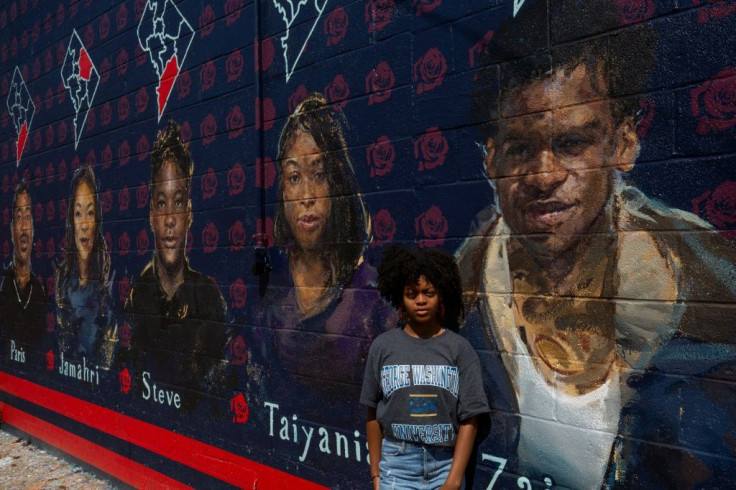In US Capital, Teen Honors Victims Of Everyday Gun Violence

The row of trendy restaurants surrounding an office of the Shakespeare Theater Company in Washington reflects the refined tastes of a gentrifying capital.
But down an alley, a mural depicts a very different drama playing out almost daily elsewhere in the same city.
There on the wall are the faces of five African-American teens shot dead, including Lauryn Renford's boyfriend, 16-year-old Zaire Kelly.
Renford, 17, was the driving force behind the mural, a recently inaugurated memorial to the slain youths.
"I think there's something very special about these five on the wall," says Renford, who sees their stories as representing other victims too.
In a country where mass shootings dominate the headlines, the mural is a reminder of more common, everyday gun crime, the victims often African-Americans, their deaths too frequently overlooked except by grieving friends and family.
Kelly was attacked in an apparent robbery attempt on his way home from studies. Jamahri Sydnor, 17, was shot while driving, the victim of an "unintended killing" according to DC Witness, a website that tracks Washington homicide cases.
Steve Slaughter, 14, and Taiyania Thompson, 16, are also pictured along with Paris Brown, 19. All were killed in 2017 and 2018.
Brown and Kelly, as well as Renford, were students at Thurgood Marshall Academy in Ward 8, one of two districts east of the Anacostia River where poverty is disproportionately clustered.
"I realized that families and even just general residents of DC should have a place to grieve the people that we've lost and always honor their legacies, and work to preserve those that are left," Renford says.
Dozens of evenly-spaced red roses symbolize others lost to gun violence but whose youthful faces aren't pictured on the wall.
That could include Maurice Scott, 15, shot dead in May, or Steffen Brathwaite, 16, gunned down the day before AFP interviewed Renford.
They are among at least 131 homicide victims this year in the city of about 700,000 residents, up from 118 at the same time last year.
Nearby Baltimore, with a slightly smaller population, has recorded around 255 homicides in 2019.
'I hear gunshots'
In contrast, 64 people have been gunned down nationwide since January in mass shootings where four or more people were killed, according to a Washington Post database.
Most of Washington's gun crime occurs in Ward 8 and adjacent Ward 7, police data show, but the mural is in a more peaceful neighborhood.
There, it helps broaden awareness among better-off residents who "don't necessarily know much about the violence" elsewhere in the city, says Renford, a first-year undergraduate hoping to study public health.
Karen Lee, a Thurgood Marshall teacher who guided Renford in creating the mural, says she is "really proud" of her.
"People are having to deal every day with violence, with shootings," says Lee, who is white and lives in the academy's neighborhood.
"I hear gunshots and I wonder if I'm going to wake up in the morning and find out that I've lost another student".
In a Washington with more and more condominiums and sleek restaurants, but a declining African-American population, Renford says making the city safer should be a task for everyone and not just a "black and brown conversation."
She joined two other Thurgood Marshall students to found an activist group, Pathways 2 Power, because they want "a seat at the decision-making table" on issues surrounding gun violence.
Poverty, inequity
The group helped her raise the roughly $12,000 needed for the mural painted by local artist Martin Swift on donated wall space.
Renford sees many roots for the violence, including poverty, gentrification, localized "beefs," and "not valuing the lives of people around you... not even your own life."
Lee highlights the need to address the inequities between Washington's wealthier neighborhoods and those where people struggle.
Armed police officers wait at the front steps of Thurgood Marshall while students in tan pants and burgundy shirts file into Martin Luther King Junior Avenue Southeast, where cars pass playing rap music.
Across the street is Bethlehem Baptist Church, the "Black Workers and Wellness Center," and a parking lot advertising the "Stop the Violence Jam" and other music shows.
Back in the alley, two elderly white women accompany a white man walking unsteadily with a cane. In front of the mural, one of the women stops and seems to call to the others. All of them look.
Paris, Jamahri, Steve, Taiyania and Zaire are looking back.
© Copyright AFP 2024. All rights reserved.





















